Tiwanaku, Bolivia- Visiting the Ruins of an Andean Civilization
Purchases made through links earn us a small commission, at no extra cost to you.
One of the joys of travelling is learning about different cultures, especially ancient ones that no longer exist.
I knew nothing of Tiwanaku culture, or the city that was the centre of their empire, until I visited the Tiwanaku archaeological site on a day trip from La Paz, Bolivia.
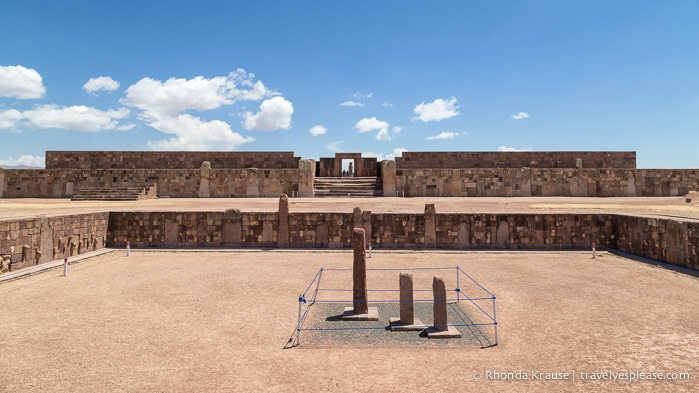
Exploring the ruins with our guide, it didn’t take long to understand why Tiwanaku (also Tiahuanaco) is considered one of the most important civilizations prior to the Inca Empire.
History of Tiwanaku
Tiwananku began as a small agricultural settlement near the southern shore of Lake Titicaca. As the community grew, Tiwanaku’s influence expanded into other settlements, eventually forming a Tiwanaku state by 300 A.D.
Between 600-800, Tiwanaku grew into a thriving city and established itself as an important power and ceremonial centre in the southern Andes. At its peak, the city of Tiwanaku had a population between 30,000 and 70,000 residents.
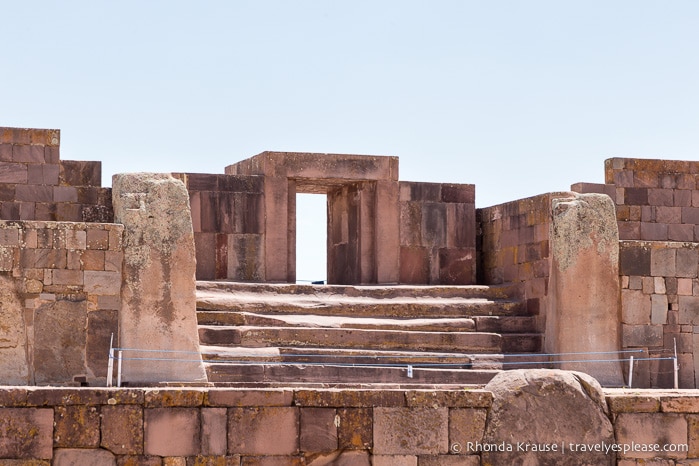
Tiwanaku continued to expand its reach through politics, trade deals, cultural influence and religious appeal, creating an empire that encompassed western Bolivia, southern Peru, and northern Chile.
The Tiwanaku empire remained strong until 1000, when its decline began. The population started to decrease, likely because of a drought that made it difficult to grow enough food, but some archaeologists believe a violent public uprising was to blame. By 1150, the Tiwanaku empire was no more.
Soon after the fall of Tiwanaku, the city was looted and damaged by amateur excavations. Further destruction occurred during the Spanish conquest through to the early 20th century. All that remains are the foundations of public buildings and some reconstructed walls.
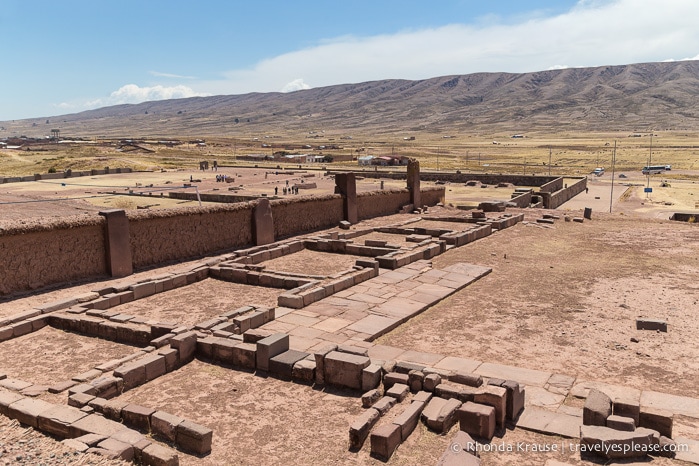
In 2000, UNESCO made Tiwanaku a World Heritage Site because of the role it played in the development of Andean pre-Hispanic civilization, as evidenced in its ceremonial, architectural and artistic contributions to the region.
Our Visit to Tiwanaku– Tour of the Tiwanaku Ruins and Museums
We visited Tiwanaku with a private guide who drove us from La Paz and spent a couple of hours showing us around the property, giving insight into Tiwanaku culture.
When I first saw the Tiwanaku ruins, I admittedly was underwhelmed and thought it wouldn’t take long to tour the site. However, there are two museums that have a lot of artifacts on display, so half of our time was spent there.
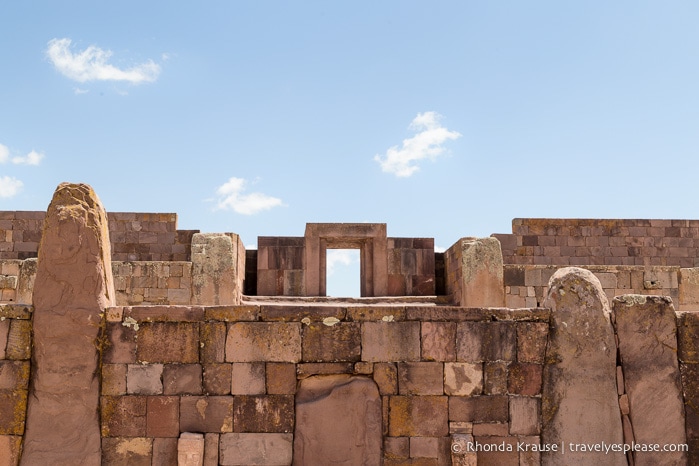
The Museums at Tiwanaku
Before exploring the ruins of Tiwanaku, we headed into the two small museums on site to learn about Tiwanaku culture.
The first museum was the Museo Ceramico, which had a large collection of pottery from the Tiwanaku civilization. We saw artistically decorated pieces reserved for ceremonies, and plain pieces used for everyday purposes.
If pots and dishes don’t excite you, don’t worry; there are other artifacts and exhibits about Tiwanaku culture on display. One of the most memorable things we saw was a mummy in the fetal position wrapped up in what looked like a potato sack.
The second museum was the Museo Litico, which housed a fabulous collection of monoliths found at Tiwanaku, some originals and some replicas. The Monolito Bennett Pachamama (Bennett Monolith) was worth the trip here alone- it’s 7.3 metres tall and covered in carvings!
Tiwanaku Archaeological Site Tour
The archaeological site of Tiwanaku consists of the ceremonial centre of the ancient city.
After passing by a large rock with a hole through the middle (an ancient megaphone!), we headed towards the focal point of the sacred centre- Akapana pyramid.
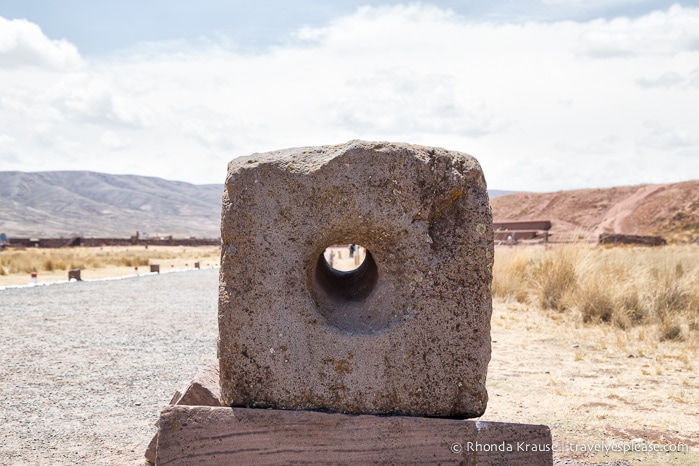
The name is somewhat misleading, as it looks more like a hill than a pyramid, due to only being partially excavated. Back in the day, the hill was shaped into seven tiers, with a staircase leading to the summit. The top was flat with a sunken court in the middle. Having to rely on my imagination, I pictured a pretty incredible structure!
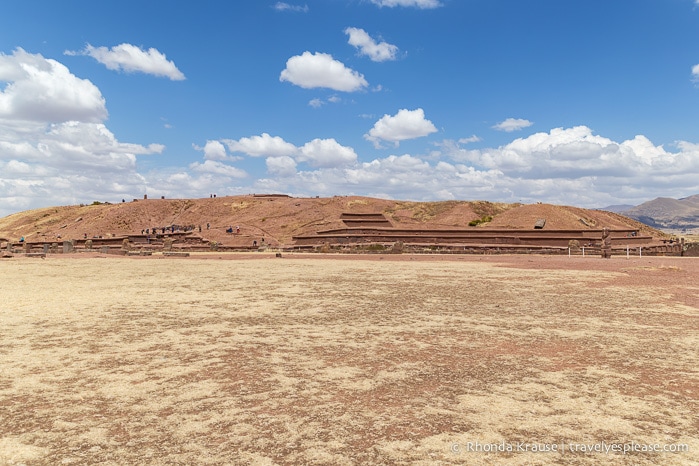
Archaeological findings here suggest that the pyramid was a ceremonial temple, possibly used in shamanic rituals.
Walking across the top of the temple, we came down the other side where we got a good look at the stonework. Notice the two different styles in the picture below? The bottom wall has large stones with slightly rounded corners, and the top wall uses smaller, straight stones.
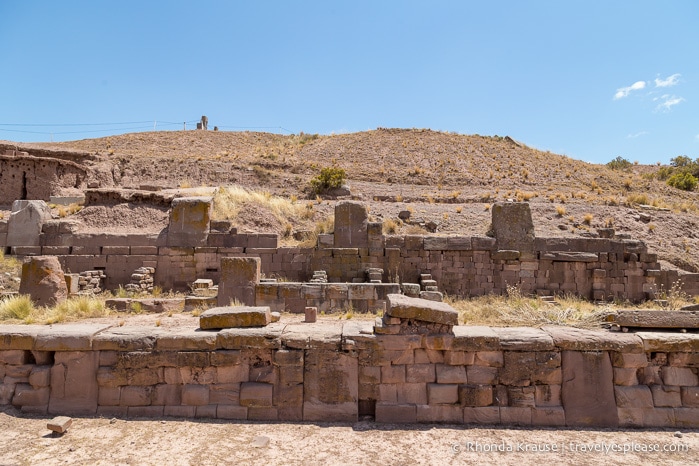
The next area we explored was my personal favourite- the Templete Semisubterraneo (Semi-Subterranean Temple). What made this sunken court so fascinating was the 175 stone heads protruding from the interior walls. No one knows for sure why they were carved or what they represent, but if you take a tour you’ll hear some interesting theories.
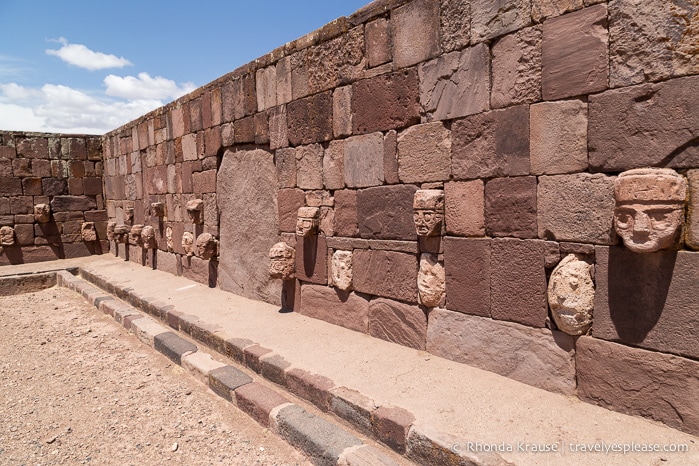
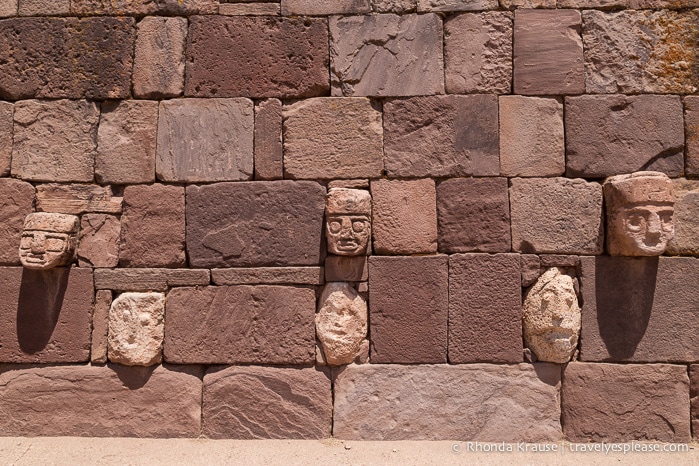
Also of interest was the fact that the Bennett Monolith was discovered in the Semi-Subterranean Temple. It was subsequently (and wrongly, in my opinion) relocated to La Paz where it stood outside the national stadium, exposed to the elements and pollution, for 69 years before being returned to Tiwanaku where it is now safely on display in the museum.
The last location we visited was Kalasasaya, a partially reconstructed walled platform with a sunken courtyard.
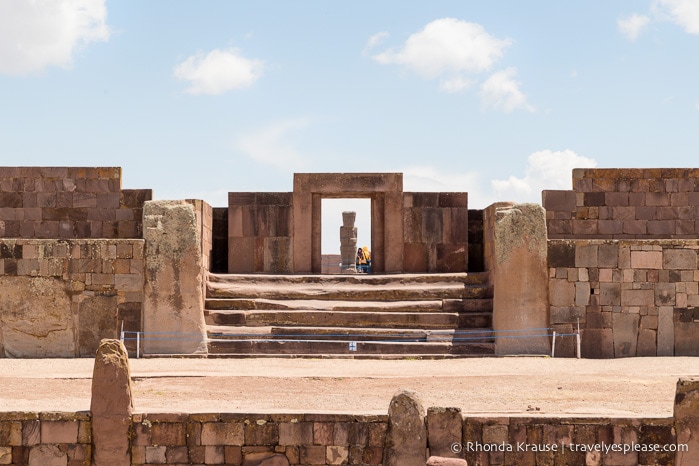
The Gateway of the Sun stands in the northwest corner but researchers believe this was not its original location. It was likely in the centre of the platform where the sun could strike specific carvings on the solstice and equinox.
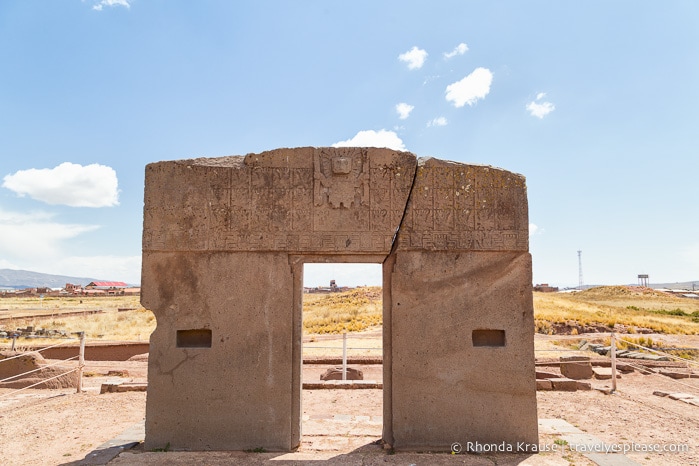
Also standing in Kalasasaya is the Ponce Monolith. It depicts some sort of ruler, or maybe a High Priest or god, holding a staff-like object in one hand and beaker/vase in the other.
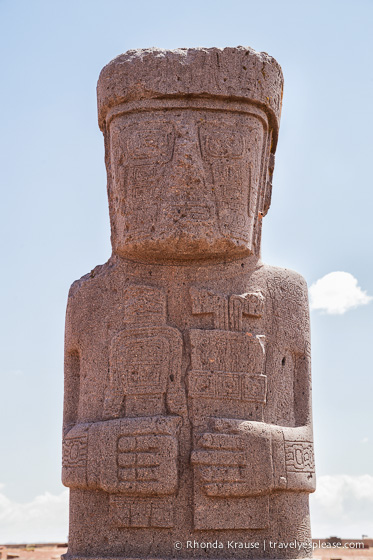
Final Thoughts About Tiwanaku
Upon entering the archaeological site of Tiwanaku, I quickly realized it was going to be very different than other ancient sites I had visited.
For one, not much of the site has been excavated. Secondly, most of what you do see has been reconstructed, and not always to a high standard.
To be fair, extensive looting has left archaeologists with a lot of missing pieces, therefore reconstructions and restorations were not sufficiently based on evidence and research.
The more I got to know the site, the more I realized how much controversy surrounds it, from an archaeological perspective.
It’s believed certain things are not in their original locations (namely, the Gateway of the Sun) and that the quality of stonework is inferior to what actually existed at Tiwanaku. The Akapana pyramid was spruced up with adobe (an effort to attract more tourists), even though research hadn’t proven that’s what the walls looked like. UNESCO even had to step in and request that work cease in order to prevent further damage to the World Heritage Site.
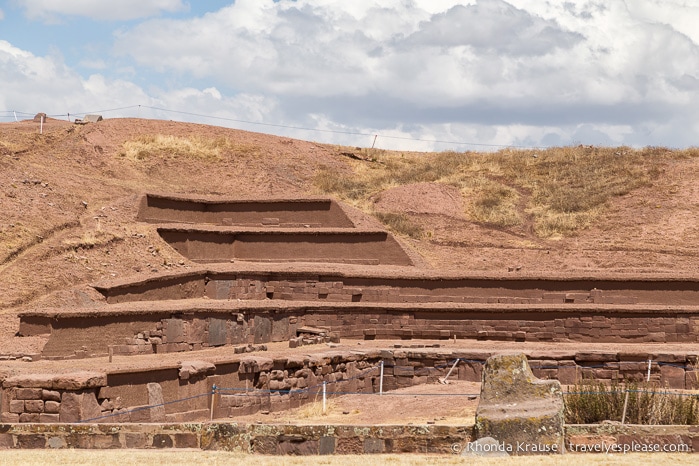
Normally I leave an archaeological site filled with wonder, impressed with what has been preserved throughout the years. I left Tiwanaku feeling sad that so little remained of the original structures and disappointed with how the excavations have been handled.
Controversies aside, Tiwanaku’s interest lies not so much in the physical site itself, but in the history, stories and myths of a lost civilization. We were lucky to have a great guide who made up for the missing “wow” factor with an abundance of interesting information about the Tiwanaku civilization.
Tiwanaku may not have been as photogenic or impressive as other ancient sites I’ve visited, but still was an intriguing place to learn about thanks to the culture of the people who called it home.
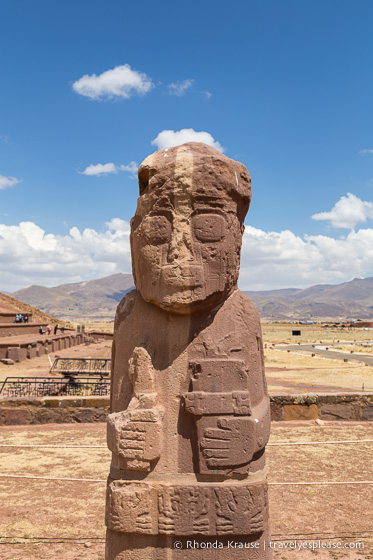
Tips for Visiting Tiwanaku
Location: The Tiwanaku ruins are about 72 km west of La Paz, near the southeastern shore of Lake Titicaca. I think it took about 1.5 hrs to drive there with all the traffic in both La Paz and El Alto.
Opening Hours: The Tiwanaku archaeological site is open daily from 9:00 am- 4:00 pm. Confirm current hours here.
Tours of Tiwanaku: To make the most of your visit to Tiwanaku, we recommend going with a private guide or on a tour. When we visited, all the labels in the museums were in Spanish and there were no pamphlets about the site.
- Many agencies in La Paz offer full and half-day tours to Tiwanaku which include transportation and a bilingual guide.
- Here is a trusted site where you can book a Tiwanaku tour.
Information was updated January 2025, but can change without notice. Please confirm directly with the venue.
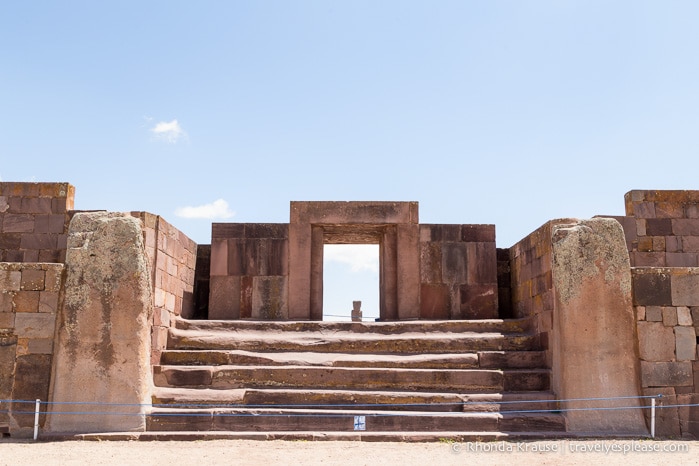
Accommodations Near Tiwanaku
For your convenience, here is a list of hotels near Tiwanaku, including properties in both La Paz and Copacabana (Lake Titicaca). Please consider booking your accommodations through the included link. It costs nothing extra and helps support this website. Thank you!
More Bolivia Destinations and Travel Guides
- What to Expect on Your First Trip to Bolivia- A First Time Visitor’s Guide
- Getting to Know Sucre- Bolivia’s White City
- A Walk in Moon Valley- La Paz, Bolivia
- Uyuni Salt Flats- Our 1 Day Tour of Salar de Uyuni
